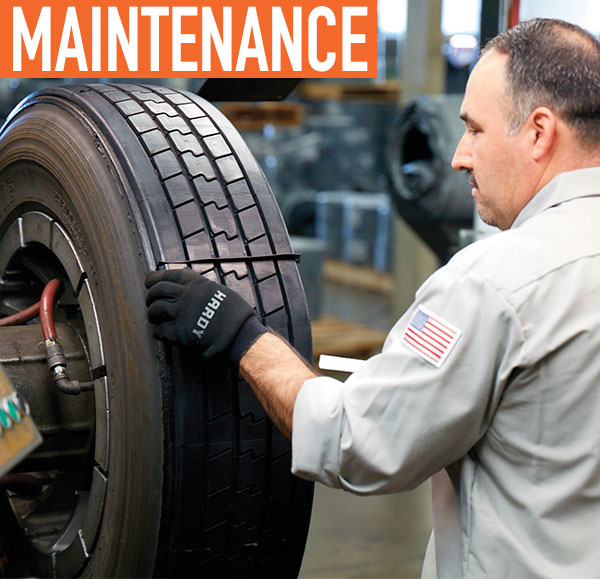When it comes to maximizing uptime, there’s one key area that fleets often overlook: proactive tire maintenance. Fleets that implement a comprehensive tire maintenance program can maximize their tire assets through proactive management rather than when an issue occurs. Properly maintained tires not only keep a fleet up and running but also help to protect a tire casing so it can be retreaded multiple times. By managing a tire throughout its lifecycle—from selection to removal—fleets can significantly impact their bottom line and make mobility more efficient.
THE BASICS
Bridgestone recommends that fleets work with a trusted dealer to develop their tire program. A dealer partner can work closely with fleet managers to develop a proactive tire management program tailored to their individual business goals, which will help prevent tire-related issues, promote safety, and maximize the value and efficiency of a fleet’s tires.To develop a custom tire program, fleets must begin with proper tire selection. When selecting a tire, fleet managers should consider the vehicle type, the gross axle weight ratings (GAWRs), speed requirements, service conditions, and tire specifications such as size, load range, and intended application. By selecting the right tire for the application, fleets can feel confident that performance expectations will be met and that they can operate more efficiently.
Most importantly, once a tire is selected, fleets should monitor and set tire inflation pressure before, during, and after a haul. Tire inflation pressure is one of the most important areas of tire maintenance as it has a significant impact on tire safety, fuel efficiency, and service life. Proper tire inflation pressure is necessary to carry the recommended load and ensure the tire performs as expected. It can also reduce the potential for irregular or rapid wear, allowing tires to stay in service longer. Bridgestone recommends fleets check and set tire pressure during pre-trip inspections and while on the road by using a properly calibrated tire gauge at each wheel position to ensure accurate measurements and adjustments.

In addition to these steps, fleets should incorporate the following best practices into their tire maintenance routines:
Visually inspect tires for irregularities before and after each haul to identify obvious concerns such as irregular wear, penetrations, bulges, sidewall cuts, mismatched dual assemblies, or issues with wheel components.
Closely monitor tread depths to ensure the tire is moved for retreading at the right time, meets DOT standards, and is not wearing through the tread package.
Implement a customized retread program to capitalize on a casing’s full performance potential for a fleet’s specific needs and application.
CAPITALIZE ON BENEFITS
With an established tire management program in place, fleets are taking the first step toward maximizing the life of their tires. To take it a step further, fleets should consider the many ways to improve fuel economy.
To do this, fleet managers can opt to fit their vehicles with fuel-efficient tires for every position. Many fleets only select fuel-efficient tires for the steer or drive position, while Bridgestone tests (recorded in its whitepaper, “Tires and Fuel Economy: A New Perspecitve) show trailer tires, which carry the bulk of the load, contribute more than any other wheel position to tire-related fuel economy. Therefore, fleets can generate savings by incorporating fuel-efficient tires at every wheel position—including the trailer position—to impact the bottom line.

Retreads are also an excellent tool for improving fuel efficiency. Studies have shown that tire casings become more fuel efficient over time as a tire’s components compact. In fact, tire casings will improve on average about 10 percent in rolling resistance after a year of use, states David Stalnaker in a Field Worn/Aged Tire Rolling Resistance presentation. When fuel-efficient tire casings and retreads are used together, fleets can maximize savings, leaving them money to reinvest in their business. For fleet owners looking to maximize tire assets and lower total cost of ownership over time, retreads are a smart, reliable choice.
THE BOTTOM LINE
Tires are one of a fleet’s most valuable assets, which is why it’s important to work with a trusted dealer partner to ensure a fleet is maximizing the performance and value of their tires. Implementing a proactive tire maintenance program and adhering to tire specifics will help fleets get the most from their tires and keep trucks on the road. And by using retreads, fleets are able to capitalize on the life of a tire casing, driving more savings over time.
ABOUT THE AUTHOR
Kyle Chen is the brand manager for truck and bus radial tires in the US and Canada for Bridgestone Americas Tire Operations. He is an industry veteran with more than 20 years of commercial tire experience. He began his career with Bandag, working in fleet sales before joining the commercial marketing team at Bridgestone Americas. Find out more about retreads, visit www.bandag.com.
MODERN WORKTRUCK SOLUTIONS: MARCH 2019 ISSUE
Did you enjoy this article?
Subscribe to the FREE Digital Edition of Modern WorkTruck Solutions magazine.





